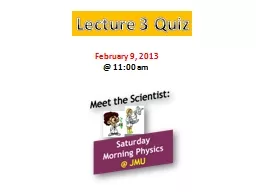

February 9 2013 1100 am T he unusually bright centers found in some galaxies are called a ctive galactic nuclei s tarbursts h alos s upermassive black holes According to current understanding what is a quasar ID: 435491
Download Presentation The PPT/PDF document "Lecture 3 Quiz" is the property of its rightful owner. Permission is granted to download and print the materials on this web site for personal, non-commercial use only, and to display it on your personal computer provided you do not modify the materials and that you retain all copyright notices contained in the materials. By downloading content from our website, you accept the terms of this agreement.
Slide1
Lecture 3 Quiz
February 9, 2013
@ 11:00 amSlide2
T
he unusually bright centers found in some galaxies are called
active galactic nuclei.starbursts.
h
alos.
s
upermassive black holes.Slide3
According to current understanding, what is a quasar?
An active galactic nucleus that is particularly bright.
Any object with an extremely large redshift.
A galaxy with an unusually high rate of star formation.
A very large galaxy thought to be formed by the merger of several smaller galaxies, typically found in the center of a galaxy cluster.Slide4
The luminosity of a quasar is generated in a region the size of
t
he Milky Way.a star cluster.
the solar system.
a
planet.Slide5
The observed relationship between the masses of central black holes and the bulge masses of galaxies implies that
t
he black holes will eventually suck in the rest of the galaxy.the biggest galaxies have the most luminous quasars.
q
uasars were more common 10 billion years ago than they are today.
g
alaxy formation and
supermassive black holes formation must be related somehow.Slide6
The best evidence for the existence of
supermassive black holes is
large quantities of high-energy emission, such as X-rays and gamma rays, and radio emission from relativistic electrons.
j
et velocities that approach the speed of light.
h
uge dark regions in the centers of galaxies, where black holes have been sucking in the galaxy from the inside out.
very high orbital velocities in a very compact region.Slide7
A quasar’s spectrum is hugely
redshifted. What do most astronomers think this large redshift tells us about the quasar?
The size of the quasar’s central
supermassive
black hole.
The type of host galaxy in which the quasar resides.
The composition of the quasar.
The distance to the quasar.Slide8
Most active galactic nuclei are found at large distances from us, with relatively few nearby. What does this imply?
Supermassive
black holes existed only when the universe was young, and no longer exist today.The jets seen in many active galactic nuclei must cause them to move far away from us.
Active galactic nuclei tend to become less active as they age.
Active galactic nuclei can form only at large distances from the Milky Way.